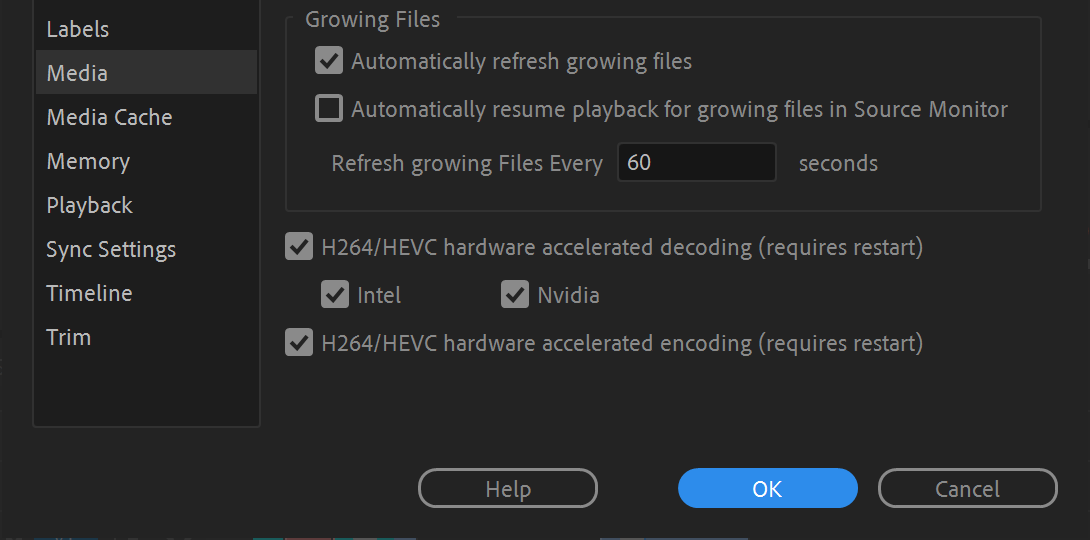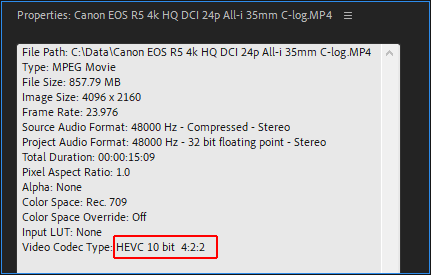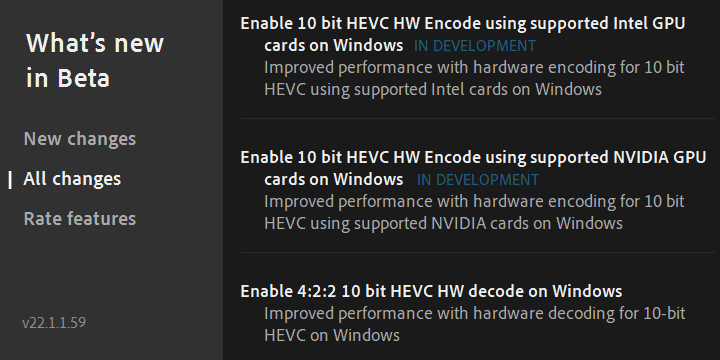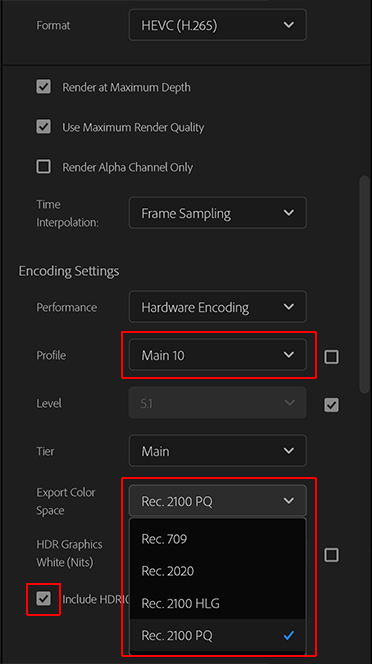The High Efficiency Video Codec (HEVC) or H.265 is a very processing intensive codec for both encode and decode, but leads to higher video quality at lower data rates. There have been both CPUs and GPUs available for years that have dedicated hardware within them to accelerate HEVC encoding and decoding. But this hardware acceleration requires specific support within software applications to utilize them. And unlike with software encoders, there are a finite number of supported encoding options that can be accelerated, each of which has to be explicitly supported. The newest updates to Premiere Pro have greatly increased the number of hardware accelerated options for HEVC workflows, greatly increasing performance with those types of files.
CPU Based Codec Acceleration
Premiere Pro has had CUDA based GPU acceleration for over a decade, since CS5, but it was not utilizing NVidia’s accelerated encode and decode hardware until recently. Adobe started with Intel’s hardware based acceleration for H.264 and HEVC encoding in version 13, which was limited to 4k at 8-bit, on CPUs with Quick Sync video processing, which from my perspective, was laptop chips. (High end Xeon CPUs don’t support Quick Sync, including the newest W-3300 chips.) The quality was also inferior to software encodes in the initial release, but that was fixed shortly thereafter. The next step was hardware accelerated decoding of H.264 and HEVC, which made editing with those codecs much more do-able on less powerful systems, especially when it came to scrubbing through footage, which is usually rough with long GOP formats.
GPU Based Codec Acceleration
Then in June of 2020, Adobe added GPU encoding acceleration to Premiere Pro 14.2. This supported hardware acceleration of H.264 and HEVC encoding with both NVidia and AMD graphics cards, regardless of your CPU. This capability was much more applicable to high end workstations, which don’t have Intel’s consumer Quick Sync feature, but of course had a top end discrete GPU. This is when I started using hardware acceleration for more than just testing purposes, and supported up to 8K on newer hardware, but it was still limited to 8bit color.
The Limits of Hardware Acceleration
Now 8-bit color was fine for most web deliverables, which was what many of those types of encodes were geared towards, but that is also about the time that we started seeing more HDR workflows being developed, and HDR definitely requires at least 10-bit color. So all HDR exports were still using the slower software encoding, and also required more processing anyway, with Max Bit Depth enabled, to actually render the extra color detail under the hood. Once accelerated encoding was pretty mainstream, my standard system benchmarking process was to encode 8K Red to 8K HEVC with hardware encoding to 8-bit Rec709, and with software encoding to 10-bit HDR, which took considerably longer. Those benchmarks were not too affected when Adobe added GPU decoding support for H264 and HEVC in Premiere 14.5, but that support really helped playback performance, especially when using multiple streams, like in a multicam timeline.
 What about newer high quality 10bit 4:2:2 HEVC recordings?
What about newer high quality 10bit 4:2:2 HEVC recordings?
With the most recent release of version 22, Adobe added support for accelerated decode of 10 bit 4:2:2 HEVC files, specific to Intel Quick Sync, because neither NVidia nor AMD currently support 4:2:2 acceleration in their GPUs. Without hardware acceleration, these newer 4:2:2 HEVC files do not play back well at all on most systems. 4:2:2 refers to the amount of color data in a file, and used to be much more frequently discussed when the industry was making the jump from SD to HD. The human eye is more sensitive to brightness than chroma, so higher resolution images could be encoded more efficiently by focusing on the luminance values over the chroma data. A 4:2:0 video file has basically half res color detail in both dimensions, while 4:4:4 file have full color data for every pixel.  4:2:2 sits between these, with full vertical but half horizontal resolution for the color data, and is the default format for SDI connections. Because H.264 and HEVC are designed to be delivery formats, they are very targeted to carrying the detail that is visible to the human eye, and dropping anything that won’t be noticed, for the sake of efficiency. But now those codecs are being used in cameras for acquisition, and the lost color detail is becoming more noticeable during grading, when highlighting image detail that otherwise wouldn’t have been visible. So camera manufacturers, who want the affordable efficiency of HEVC encoding, but better quality imagery, have started using HEVC encoding on 4:2:2 image data. Specifically the Canon R5 & R6, as well as Sony’s A7s3, and other DSLRs that continue to be released, use this new format, which is not as widely supported for hardware accelerated playback. But users of Premiere Pro 22 who have Intel Quick Sync support on their newer CPUs (11th gen graphics or higher), should now have much smooth playback of files from those cameras, on the order of ten times the frame rate for real-time playback, and three times faster processing for export or transcoding tasks.
4:2:2 sits between these, with full vertical but half horizontal resolution for the color data, and is the default format for SDI connections. Because H.264 and HEVC are designed to be delivery formats, they are very targeted to carrying the detail that is visible to the human eye, and dropping anything that won’t be noticed, for the sake of efficiency. But now those codecs are being used in cameras for acquisition, and the lost color detail is becoming more noticeable during grading, when highlighting image detail that otherwise wouldn’t have been visible. So camera manufacturers, who want the affordable efficiency of HEVC encoding, but better quality imagery, have started using HEVC encoding on 4:2:2 image data. Specifically the Canon R5 & R6, as well as Sony’s A7s3, and other DSLRs that continue to be released, use this new format, which is not as widely supported for hardware accelerated playback. But users of Premiere Pro 22 who have Intel Quick Sync support on their newer CPUs (11th gen graphics or higher), should now have much smooth playback of files from those cameras, on the order of ten times the frame rate for real-time playback, and three times faster processing for export or transcoding tasks.
 10-bit Encoding Acceleration
10-bit Encoding Acceleration
The most recent feature, that just appeared in the Premiere 22.1.1 beta, is 10bit HEVC accelerated encoding, which includes support for HDR output formats, and runs on Intel CPUs or NVidia GPUs. My initial tests showed my standard benchmarking encodes completing 4 times faster on my workstation (which can already encode pretty fast in software on the top end CPU), and 16 times faster on my Razer laptop. Hardware acceleration usually makes a bigger difference on less powerful systems, because the system has less spare processing power to throw at the software encoding implementation. So this new 10 bit encoding acceleration will greatly aid those working in HDR, especially if they are on an Intel laptop, and all the more so if they don’t have a discrete GPU (Which I wouldn’t usually recommend editing on). HEVC export is limited to 4:2:0 color-space, because no one should need to be outputting 4:2:2 HEVC for delivery, and HEVC is not a good choice for intermediate exports, even at 4:2:2. But if you have a top end DSLR shooting 4:2:2 HEVC files, and you want to edit on a laptop and post your work to YouTube in HDR, the playback and export of your project is going to be a whole lot better with the newest version of Premiere, than it would have been before.

